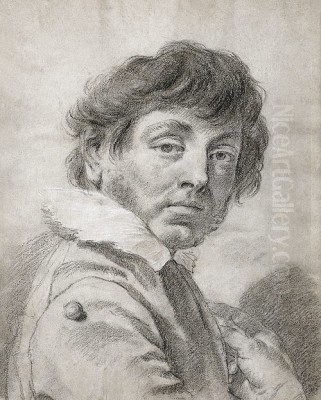
Giovanni Battista Piazzetta stands as one of the most compelling figures of the Venetian Settecento, an artist whose work masterfully navigated the transition from the dramatic intensity of the Baroque to the lighter graces of the Rococo. Born and primarily active in Venice, a city then experiencing its final, brilliant flourish as a cultural capital, Piazzetta developed a distinctive style characterized by rich chiaroscuro, warm tonalities, and profound psychological sensitivity. Though perhaps less prolific than some of his contemporaries, his influence as both a painter and a teacher was profound, leaving an indelible mark on the course of 18th-century European art. His journey reflects a deep engagement with artistic tradition while forging a unique path defined by technical brilliance and emotional depth.
Early Life and Formative Influences
Giovanni Battista Piazzetta was born in Venice, likely on February 13, 1683, although the year 1682 is sometimes cited. His father, Giacomo Piazzetta, was a respected woodcarver and sculptor, providing the young Giovanni Battista with his earliest artistic training. This initial grounding in sculpture likely instilled in him a strong sense of form and volume, which would remain evident throughout his painting career. Recognizing his son's talent lay more with the brush than the chisel, Giacomo apprenticed him around 1697 to the painter Antonio Molinari. Molinari was a competent practitioner of the late Venetian Baroque style, known for his dynamic compositions and somewhat tenebrist leanings, offering Piazzetta a solid foundation in the prevailing local tradition.
A pivotal moment in Piazzetta's development occurred when he traveled to Bologna around 1703-1705. There, he entered the orbit of Giuseppe Maria Crespi, a highly original artist whose work profoundly impacted the young Venetian. Crespi, known affectionately as "Lo Spagnuolo" (The Spaniard) for his dark palette, was celebrated for his genre scenes, his expressive brushwork, and his dramatic use of light and shadow. Crespi's own style drew heavily on the Bolognese tradition, particularly the work of Guercino, and ultimately looked back to the revolutionary chiaroscuro of Caravaggio. Piazzetta absorbed Crespi's lessons on capturing emotion, utilizing tenebrism for dramatic effect, and finding significance in everyday subjects. This Bolognese sojourn was crucial in shaping Piazzetta's unique artistic voice.
Return to Venice: Forging a Path
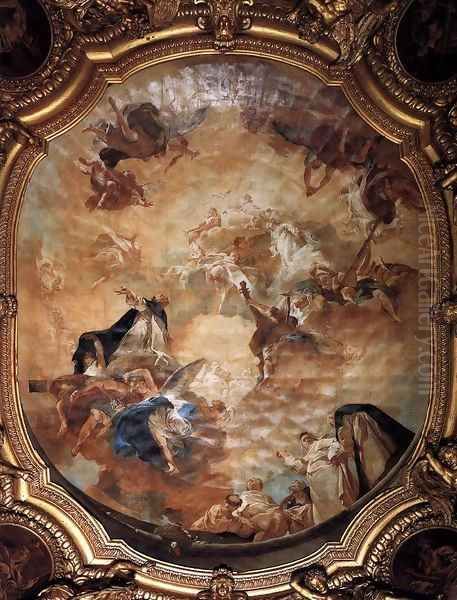
Around 1711, Piazzetta returned to his native Venice, equipped with a sophisticated understanding of both Venetian colorito and Bolognese disegno and chiaroscuro. He established his own studio and began to build his reputation. His early independent works clearly show the influence of Crespi and the tenebrist tradition, characterized by dark backgrounds, strong contrasts of light and shadow, and robust figures. He arrived back in a city teeming with artistic talent, where the grand legacies of Titian, Veronese, and Tintoretto still loomed large, but where new trends were also emerging.
Piazzetta quickly distinguished himself from the more decorative tendencies gaining traction in Venice. While artists like Sebastiano Ricci were exploring a lighter, more fluid Rococo manner, Piazzetta initially maintained a more somber, emotionally charged approach. His figures possessed a weight and psychological presence that set them apart. He began receiving commissions, primarily for religious works, which allowed him to showcase his ability to handle complex narratives and convey deep spiritual feeling through his powerful command of form and light.
The Language of Light and Shadow
Piazzetta's mastery of chiaroscuro is central to his art, yet his approach evolved distinctively from his influences. While indebted to Caravaggio and refined through Crespi and Guercino, Piazzetta's use of light and shadow developed its own unique character. It was less stark and confrontational than Caravaggio's, often employing softer transitions and a warmer, more atmospheric quality. Light in Piazzetta's work does more than simply illuminate; it sculpts form, creates mood, directs the viewer's eye, and reveals the inner state of his subjects.
His shadows are seldom empty voids; they are rich, deep, and full of subtle variations in tone, contributing significantly to the overall composition and emotional resonance. He often used a focused light source to highlight key figures or gestures, allowing surrounding areas to recede into evocative darkness. This technique lent an air of intimacy and mystery even to large-scale public commissions. The interplay of light and dark became Piazzetta's primary tool for exploring human emotion and imbuing his scenes with dramatic, yet often tender, intensity. This nuanced handling of chiaroscuro remained a hallmark of his style throughout his career, even as his palette gradually lightened.
Monumental Religious Narratives
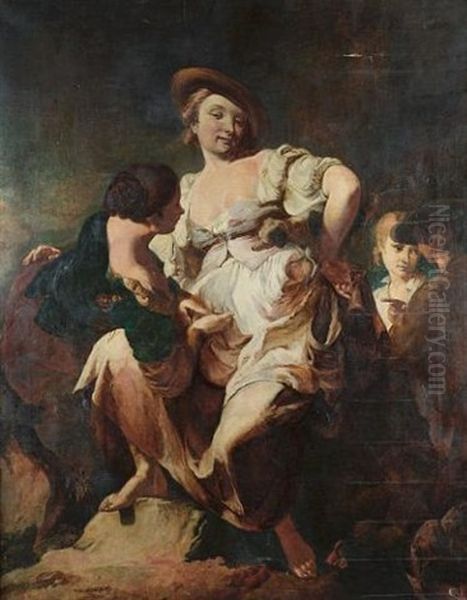
Piazzetta's reputation was significantly built upon major religious commissions for Venetian churches. One of his early masterpieces is the Martyrdom of St. James the Greater, painted around 1722 for the church of San Stae (though sometimes associated with an earlier version or study). This powerful work exemplifies his early mature style, showcasing dynamic composition, forceful figures caught in dramatic action, and an intense emotionalism heightened by the stark contrasts of light and shadow. The focus is squarely on the saint's suffering and faith, rendered with palpable physicality.
Perhaps his most celebrated public work is the ceiling painting, The Glory of St. Dominic, executed between 1725 and 1727 for the Chapel of Saint Dominic in the Basilica di San Giovanni e Paolo (SS. Giovanni e Paolo) in Venice. This complex work demonstrates his ability to handle large-scale fresco decoration, though he worked primarily in oil. The composition features the saint ascending towards heavenly light, surrounded by swirling angels and allegorical figures. While retaining dramatic chiaroscuro, the overall effect is somewhat lighter and more open than in the St. James, hinting at the emerging Rococo sensibility. The skillful foreshortening and sense of upward movement create a powerful illusionistic effect, cementing Piazzetta's status as a leading religious painter in Venice.
Intimate Visions: Genre and Portraiture
Beyond large-scale religious works, Piazzetta excelled in smaller, more intimate formats, particularly genre scenes and expressive head studies known as teste. These works often depict peasants, artisans, or anonymous figures, allowing Piazzetta to explore character and emotion without the constraints of traditional iconography. His teste are particularly noteworthy; often executed in charcoal or chalk heightened with white, they are powerful studies of expression and physiognomy, demonstrating his keen observation skills.
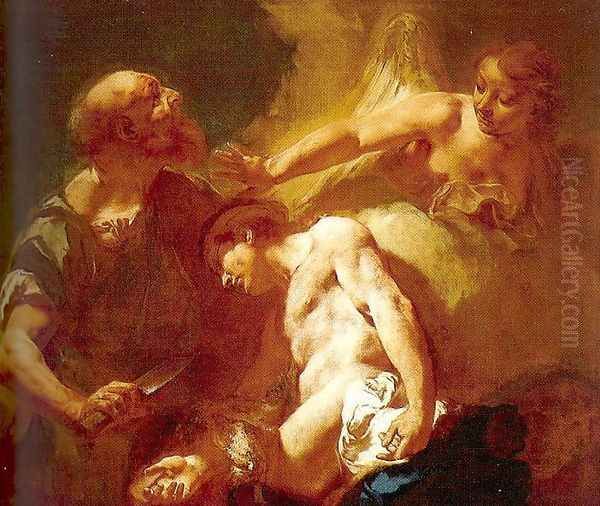
Paintings like The Fortune Teller (c. 1740, Gallerie dell'Accademia, Venice) are masterpieces of psychological interplay and subtle narrative. The ambiguous relationship between the figures, the rich textures of their clothing, and the complex lighting create a captivating scene. Similarly, works such as A Boy with a Lute (c. 1740) or A Young Girl with a Spindle capture moments of everyday life with remarkable sensitivity and often an underlying sense of drama or introspection. Piazzetta frequently used members of his own family as models for these works, including his wife, Rosa Muzzioli (whom he married in 1724 and with whom he had seven children), and his children, such as Giacomo and Barbara. This practice likely contributed to the naturalism and emotional authenticity of these paintings. His Portrait of Giulia Lama (c. 1715-1720), depicting a fellow female artist, showcases his ability to capture personality with warmth and subtlety, using softer tones characteristic of his evolving style. This focus on intimate human moments offered a different facet of Venetian life compared to the society portraits of Rosalba Carriera or the grand vistas of Canaletto.
The Prolific Draughtsman and Illustrator
Piazzetta was an exceptionally gifted draughtsman. Drawing formed the foundation of his practice, used not only for preparatory studies for paintings but also as finished works of art in their own right. His numerous teste in charcoal or chalk on tinted paper are highly sought after, admired for their technical virtuosity and expressive power. These drawings reveal his deep understanding of anatomy and his ability to capture fleeting expressions with remarkable economy of means.
His skill as a draughtsman also led him to become a significant book illustrator. His most famous project in this field was the series of illustrations for the monumental 1745 edition of Torquato Tasso's epic poem Gerusalemme Liberata (Jerusalem Delivered), published by Giambattista Albrizzi. Piazzetta designed numerous full-page plates and vignettes, which were then engraved by others, most notably Marco Pitteri. These illustrations successfully translated the drama and sensitivity of his paintings into linear form, enhancing the text and reaching a wide audience. His collaboration with skilled engravers like Pitteri and Teodoro Viero was crucial in disseminating his compositions and style throughout Italy and Europe, significantly contributing to his international reputation.
A Respected Teacher: The Piazzetta Workshop
Piazzetta maintained an active workshop and was a highly respected teacher, attracting numerous pupils who were drawn to his distinctive style and technical mastery. His teaching methods emphasized strong drawing skills and a deep understanding of light and shadow. Among his most notable students were Domenico Maggiotto, who became a close follower and sometimes imitator of his master's style; Francesco Capella; Johann Heinrich Tischbein the Elder, who carried Piazzetta's influence to Germany; Egidio Dall'Oglio; and Antonio Marinetti. Francesco Polazzo and Federico Bencovich were also associated with his circle, though Bencovich was more of a contemporary influenced by similar trends. The painter Giulia Lama had a close professional relationship with Piazzetta, possibly studying alongside him or collaborating, though the exact nature of their artistic connection is debated.

His dedication to artistic education culminated in his appointment in 1750 as the first Director of the newly established Accademia di Belle Arti di Venezia (Venice Academy of Fine Arts), where he also headed the Scuola di Nudo (School of Life Drawing). This prestigious position acknowledged his standing within the Venetian art community and allowed him to shape the training of the next generation of artists. His influence extended through his students, ensuring the continuation of certain aspects of his style and approach well into the latter half of the 18th century.
Navigating the Venetian Art World
Piazzetta occupied a unique position within the vibrant Venetian art scene of the Settecento. He was a contemporary of major figures pursuing different artistic paths. Sebastiano Ricci represented a more decorative, internationally oriented Rococo style. The younger Giovanni Battista Tiepolo, arguably the greatest decorative painter of the era, initially showed Piazzetta's influence in his handling of light and shadow but soon developed his own brilliantly lit, airy, and theatrical manner that would come to define the Venetian Rococo ceiling painting. Meanwhile, Canaletto and Francesco Guardi were perfecting the veduta or view painting, capturing the city's topography and atmosphere.
Compared to these artists, Piazzetta's focus remained more on the human figure, psychological depth, and the expressive potential of chiaroscuro. His work offered a more somber and introspective counterpoint to the dazzling lightness of Tiepolo or the elegant pastels of Rosalba Carriera. He maintained connections to the earlier Venetian Baroque tradition, echoing the robustness of figures like Domenico Fetti and Bernardo Strozzi, while simultaneously refining his technique towards Rococo sensibilities. This blend made his work distinct and highly valued, though perhaps less suited to the vast decorative schemes favored by some patrons.
Later Career and Artistic Practice
Throughout his career, Piazzetta was known for his deliberate and meticulous working method. This careful approach, while ensuring high quality, meant he was less prolific than some contemporaries, earning him nicknames suggesting slowness, such as "il bradipo" (the sloth) or simply "the snail." This methodical pace may have contributed to periods of financial difficulty, despite his considerable artistic reputation. Patrons sometimes had to wait extended periods for commissioned works.
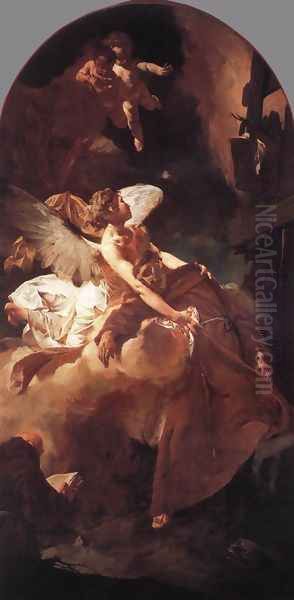
Art historians have noted that some of Piazzetta's later works, particularly from the 1740s onwards, occasionally exhibit a certain darkening or yellowing of the palette and perhaps a slight decrease in the vibrant energy seen in his prime. This could be attributed to various factors, including changes in pigments over time, studio assistance in larger commissions, or simply the natural evolution of an aging artist's style. Nonetheless, he continued to produce significant works and remained a respected figure until his death. His commitment to teaching at the Accademia occupied much of his energy in his final years.
Enduring Legacy and Critical Fortunes
Giovanni Battista Piazzetta died in Venice on April 28, 1754. He left behind a significant body of work that bridges the gap between the dramatic intensity of the Baroque and the refined elegance of the Rococo. His unique synthesis of Bolognese chiaroscuro and Venetian sensitivity to color and atmosphere created a powerful and enduring artistic language. His influence, particularly on the early development of Tiepolo, was crucial, though Tiepolo ultimately moved in a different direction.
Piazzetta's critical reception has fluctuated over time. During his life and shortly after, he was highly esteemed, particularly for his religious works and expressive drawings. His influence spread internationally, especially in Germany and the Netherlands, largely thanks to the engravings made after his designs. In later periods, he was sometimes overshadowed by the sheer brilliance and decorative appeal of Tiepolo. However, modern scholarship has increasingly recognized Piazzetta's distinct contribution, valuing his psychological depth, his masterful control of light, and his role as a pivotal figure in the evolution of 18th-century Venetian painting. His works continue to be admired in major museums worldwide, securing his place as a major master of the Venetian Settecento, an artist whose luminous shadows continue to captivate viewers.